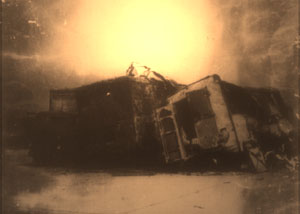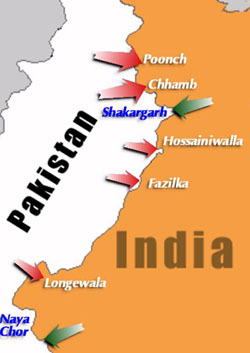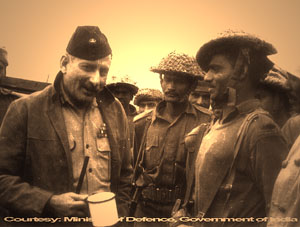PAF Strikes
 For all practical purposes, the war
started at about 5:40 pm on 3 December when Pakistan Air Force (PAF) combat aircraft struck nine Indian airfields along the Western borders. The air strikes were followed by a massive attack on the strategic Chhamb sector in the north. In the East, it was the Indian Army which
went on the offensive. By late that night, artillery shells were raining down all along the Western and Eastern borders. India and Pakistan were locked in a two-front war. For all practical purposes, the war
started at about 5:40 pm on 3 December when Pakistan Air Force (PAF) combat aircraft struck nine Indian airfields along the Western borders. The air strikes were followed by a massive attack on the strategic Chhamb sector in the north. In the East, it was the Indian Army which
went on the offensive. By late that night, artillery shells were raining down all along the Western and Eastern borders. India and Pakistan were locked in a two-front war.
In the West, the Indian Army had very limited offensive aims and was relegated more to a holding role. The initiative lay with Pakistan. In this theatre, Pakistan had near parity with India in armour and artillery while India had more infantry divisions. Pakistan's most successful thrust was in Chhamb where the 23rd Pakistani Division (along with two additional infantry brigades, one extra armoured brigade and Corps artillery units) under the able leadership of Major General Iftikhar Khan completely overwhelmed the forward defensive positions of the Indian 10 Division commanded by Major General Jaswant Singh. Chhamb village was taken and the Pakistanis threatened to advance towards Jammu, the summer capital of the state of Jammu & Kashmir. Heavy fighting continued in this sector for a week until the indecisiveness of the Indian Divisional commander forced the Indian Corps Commander to intervene personally and launch heavy attacks to push the Pakistanis back to a non-threatening position. The Pakistanis surprisingly failed to take advantage of their initial successes in this sector and actually depleted the forces available to their commander, who was killed on 10 December in a helicopter crash.
 Acting in accordance with its strategy to grab as much territory in the West as possible, Pakistan also launched a major attack on Punch in the state of Jammu & Kashmir. This attack, unlike the one on Chhamb, was completely repulsed, although here the Indian Army was at a locational disadvantage since the Pakistanis controlled the heights around the town. Smaller attacks were launched by Pakistan in Punjab at Fazilka and Hussainiwala. Here the forward Indian defences were breached but the Pakistani Army could not sustain its attacks. A more ambitious armoured thrust in the deserts of Rajasthan was similarly stopped in the famous Battle of Longewal. In all, it appeared that the Pakistani military high command could not make up its mind as to where it should deliver its main punch and kept pulling back until it was too late.
Acting in accordance with its strategy to grab as much territory in the West as possible, Pakistan also launched a major attack on Punch in the state of Jammu & Kashmir. This attack, unlike the one on Chhamb, was completely repulsed, although here the Indian Army was at a locational disadvantage since the Pakistanis controlled the heights around the town. Smaller attacks were launched by Pakistan in Punjab at Fazilka and Hussainiwala. Here the forward Indian defences were breached but the Pakistani Army could not sustain its attacks. A more ambitious armoured thrust in the deserts of Rajasthan was similarly stopped in the famous Battle of Longewal. In all, it appeared that the Pakistani military high command could not make up its mind as to where it should deliver its main punch and kept pulling back until it was too late.
The Indian Army chief, General Sam Maneckshaw, had a completely different set of problems. His strategy had to take into account the Chinese, with whom the Indian Army had fought a full blown war only nine years earlier. The Chinese were now firm Pakistani allies and had been making threatening noises ever since India resolved to intervene in the East Pakistan issue. General Maneckshaw, despite the disappointment of his Corps and divisional commanders, had to hold back his Army in the West, keep a watchful eye on the long and difficult Chinese borders and, at the same time, ensure that his Eastern Army secured its objective of grabbing a good chunk of East Pakistani territory
within 2 to 3 weeks. The Indian aim was to install a Bangladeshi interim government in East Pakistani territory before the cessation of hostilities. It was not all clear in the beginning whether things would work out quite the way as planned.

 
Part Three: Entering
East Pakistan
|